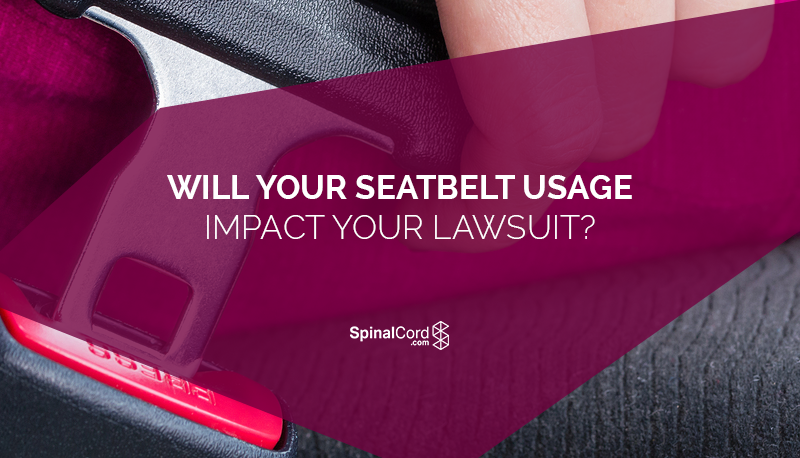Will Your Seatbelt Usage Impact Your Lawsuit?

A personal injury lawsuit may seem like a scenario that you will never have to face, but the fact that 250,000 people are dealing with a spinal cord injury -- many of which led to subsequent litigation -- puts it into perspective a bit. Anyone can find themselves in the unfortunate situation of seeking relief for some horrific incident caused at least in part by outside forces, especially when one considers that the vast majority of spinal cord injuries are caused by vehicular accidents. Car accidents account for more than 33 percent of these cases, and when it comes time to determine grounds for a lawsuit, one point that will likely be leveraged by the opposing side is whether a seat belt was securely fastened when the accident occurred.
Dubbed the “seat belt defense” in some circles, this legal tactic is used by defending attorneys to shift blame in a personal injury case from the defendant to the plaintiff, thereby undermining the validity of the latter’s claims of wrongdoing. For example, if a defendant discovers that the injured party was not wearing his or her seat belt during the time that the accident took place, it’s far easier to deflect accusations onto the plaintiff. The question of blame for the incurred damage is then more in doubt, and some may worry that the lack of a seat belt could turn out to be the deciding factor in their case.
Because medical costs for serious injuries like a spinal cord injury can have a crippling effect on a family’s financial situation, mounting a case will often be viewed as a wise alternative to taking on the mountain of looming debt unassisted. If a third party played an integral role in that fateful incident, it’s within your right to pursue justice, and the question of seat belt usage shouldn’t scare you away from looking into the possibility of receiving some relief. To better understand your rights, perhaps we should delve into exactly what qualifies a case for a credible personal injury lawsuit in the first place.
The Blame Game
In order for a personal injury lawsuit to hold much water in court, the claim must fit into one of the two basic categories: negligence and faulty (or defective) products. Each of these assert that an outside force was directly responsible for the accident that occurred, and they allow the plaintiff the opportunity to prove beyond a reasonable doubt -- whether they were wearing a seat belt or not -- that the resulting injuries were unavoidable on their own end.
Negligence, for example, is the most common type of claim. This occurs when an individual fails to perform his or her duty, either through poor execution of their responsibilities or failure to perform them at all. When it comes to car accidents, the simplest version of this is reckless driving. So, if another driver blows through a red light and slams into another person’s vehicle, causing the latter to develop a brain or spinal cord injury, that first driver demonstrated negligence on the road, directly causing the damage.
Likewise, faulty (or defective products) would instead be an instance in which some part of a person’s vehicle malfunctioned, and that’s when the accident happened. However, this must be a demonstrable defect in the vehicle itself and not simply an example of poor maintenance on the part of the driver, as that would again shift blame back onto the plaintiff. The manufacturer had to have overlooked some design or manufacturing flaw for faulty products to be the crux of a personal injury case, and the plaintiff’s claim would, of course, need to be illustrated thoroughly to support that.
Fasten Your Seat Belt
Although wearing seat belts whenever you find yourself in a vehicle is always a wise decision, the actual laws governing the requirement of doing so can vary greatly from state to state. Even in those states wherein wearing a seat belt is mandatory, most courts will not simply allow the absence of a secured seat belt to excuse fault from any third party that might be to blame for an ensuing injury. As they say, “two wrongs don’t make a right,” and the presence of a seat belt might not have prevented injury from occurring anyway. Again though, this is contingent on a number of factors that will depend on your specific case.
So the “seat belt defense” doesn’t carry quite the weight it may have once held in personal injury cases. Don’t allow the worry about your seat belt keep you from exploring your options, as you very well still might be able to assemble a compelling case with the right attorney on your side. Moreover, it’s important to be ready for the possibility of a vehicular accident, as one can strike at any moment and without provocation. After all, there is much to consider when an accident does occur. For more information about the current legal stipulations in your state, reach out to an attorney. It’s always a good idea to know your rights before the unfortunate situation arises where you may find yourself in court.
Stay Updated on Advancements On Traumatic Brain &
Spinal Cord Injuries
About the Author





